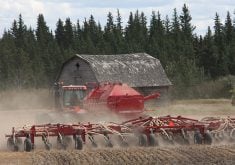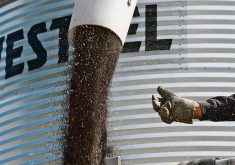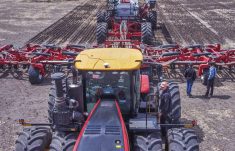With seeding activity in full swing across the West, safety advocates are reminding producers to take extra care when operating and moving farm equipment.
Marcel Hacault, executive director with the Canadian Agricultural Safety Association, said spring and fall are typically the busiest times of the year on prairie grain farms.
That means the risk of being injured or killed while operating or moving large pieces of farm equipment is greater than ever.
“Most of the farm fatalities that we see are happening with equipment,” said Hacault.
Read Also

Using artificial intelligence in agriculture starts with the right data
Good data is critical as the agriculture sector increasingly adopts new AI technology to drive efficiency, sustainability and trust across all levels of the value chain.
“If you’re operating farm equipment, take those rest breaks. Take your time and try not to succumb to the temptation to rush and cut corners….”
According to Hacault, fatigue and lack of adequate rest are among the top factors contributing to farm injuries involving machinery.
Many new farm machines have features designed to increase efficiency and reduce operator stress.
But those same features might be contributing to a lower level of operator awareness.
They can also prompt farmers to push themselves beyond their capabilities.
“I know you have GPS and autosteer on a lot of newer machines but that might even cause farmers to work longer hours,” Hacault said.
“For example … you used to have to quit spraying when you couldn’t see the foam droplets at the end of the booms. But nowadays, with GPS, if the weather’s right, you can keep spraying all night long if you like.”
Hacault said some new machines also have sensors and switches designed to disable or stop machinery if it senses a potential hazard.
For example, some tractors have seat sensors designed to stop the machine if the operator is not properly seated.
Hacault said farmers should ensure safety sensors are maintained and fully operational.
“I would really encourage farmers not to bypass safety switches,” he said.
Some serious injuries occur when tractor operators disable switches and dismount so they can ensure implements being towed are functioning properly.
Mounting and dismounting a moving machine is extremely dangerous.
Run–overs are still among the most common type of injury to occur on Canadian farms each year.
Shields and guards should also be kept in place and inspected regularly to ensure they are providing the intended level of operator protection.
In the spring and fall, large farm machines are frequently being moved from field to field on public roads and highways.
Both farm operators and drivers of regular vehicular traffic should take extra time and precaution when meeting or passing on public roadways.
Today’s farm machines are larger and heavier than ever and they take up more space on roads, Hacault added.
Rollovers can occur when large pieces of machinery pull over too far and slip sideways on soft road shoulders, he added.
Transporting farm equipment on public roadways requires special care and attention.
Machinery being transported on highways or gravel roads should always be fully illuminated and should be equipped with proper flashers and signage.
Farm equipment operators should make themselves aware of provincial rules that regulate the transportation or movement of large farm machines.
“I think that’s one area where we’re seeing an increase in farm fatalities is in motor vehicle collisions with farm equipment,” Hacault said.
“And generally speaking, it’s not the farmer that has the worst outcome. It’s usually the person in the other vehicle.”
















